|
| |
The Tompson patent box lock
Please click on images to enlarge
|
I have seen the name Tompson on
several box locks.
I have yet to research the
patents office.
The special quality of the lock
is probably is the way the tennon can retract into the lock and enable a
flat surface to be achieved when the lock is open.
The tennon is the bit that sticks
out! there is in this lock a mechanism to countersink; I think this is
probably the invention/ the special of the patent.
A patent is like a field: the
description has to separate the new idea from that which has gone before.
The description has to be wide enough to hold the idea. It has to also be
defendable.
Some boxes of a slightly later
style with rosewood veneers rather than mahogany have an escutcheon which
reads Tompsons patent: see http://www.hygra.com/wb/wbdg12.htm
There is a "Tompson,
William, Patent Lock Mkr, Key Stamper, Bull St." in the Birmingham
directory for 1818.
|
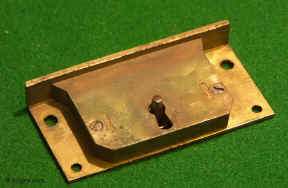
|
The body of this particular
lock is of cast brass. This would then have been milled to achieve
greater accuracy
of working
|
Please click on images to enlarge
Some boxes with Tompson locks have an elaborate escutcheon.
The escutcheon is gilded
brass and reads Tompson Patent
This example is from a
rosewood writing box.
The Tompson lock straddles the mahogany and
rosewood periods.
|
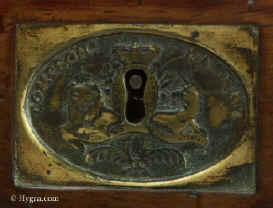
|
Please click on images to enlarge
New keys can be cut for these locks without taking the box apart or
taking the lock out. The key is the biggest that fits in! There is a cut
for the ward, the circular structure which would deny access with
a simple pick to the first lever, or tumbrill as they were called at the
time. The only other cut that is necessary is to enable the sprung
levers to be lifted to the right height and no further.
The warding of this lock is simpler some others others of period.
The
security is in the levers. which were called tumblers at the time. The particular mechanism
of the Tompson lock is the double movement of the bolt mechanism which first moves up, then across.
This enables the lock tennons to be withdrawn into the lock.
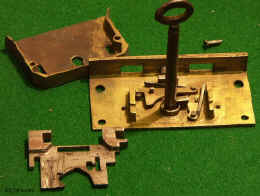
|

Background:
Robert Barron, invented the double tumbler lock in 1778, a
major refinement of the ward lock. The tumbler, a lever that falls into
a slot in the bolt, preventing any movement, until picked up by the key
to the height of the slot. This had to be done for each of the two
tumblers at varying heights, then the key would slide the bolt.
Barron's innovation is still the basis of all lever locks
including Thompson's
|
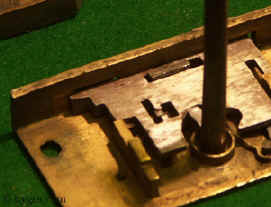
|
The ward is visible from the keyhole. It is often difficult to
find a key blank. the key tennon of the Georgian key tends to be longer than
the Victorian.
|
Please click on images to enlarge
Please click on images to enlarge
| As the key is turned the lock bolt tennons and register emerge from the lock;
as the key is further turned the first tennons move to the left and
engage with the lock plate. |
Below is an earlier example of the
lock marked Tompson and
Lambley --GR Patent.
The firm of LAMBLEY A
& CO PORTABLE WRITING DESK MFR LADIES' WORK CASE MFR
Birmingham was active from 1800.
Both he and Tompson are in
the Wrightson's Triennial Directory for 1818
|

|
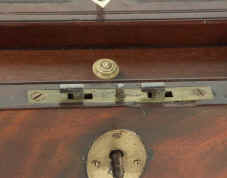
|
Here the tennons are shown
in the locked position.
also in this picture is the
turned knob of the pen compartment. The curved pen tray was introduced
circa 1800.
|
Please click on images to enlarge
Thomson was so proud of his patent that some boxes have an
escutcheon bearing the unicorn and lion logo of Britain.
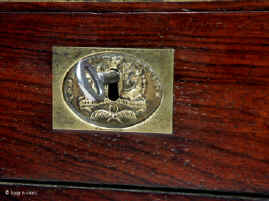
The escutcheon is gilded
brass and reads Tompson Patent.
|

|
| The lock plates are differently marked every few years, the cutting and the
positioning also changes. The GR patent, George Rex patent, marked with a crown
was clearly important for William Tompson. |
Please click on images to enlarge
The box has two keys. The larger is
the main key; the smaller is for one of the flaps.
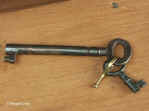
The larger key is for the Tompson lock.
The lock is special in that it has a triple action.
In the open position the tennon is flush with the lockplate.
As the key is turned the lock tennon and a positioning rod
first emerge from the lock plate. As the key continues to be turned
the tennon moves to the left and latches on to the upper plate
securing the box in the locked position
|
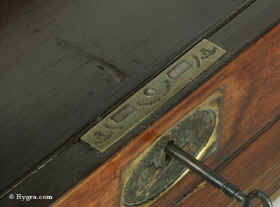
Lock in open position
|
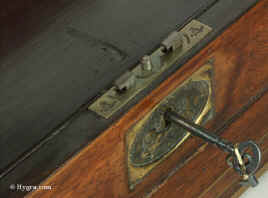
Lock in engaged position
|
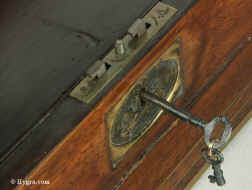
Lock in locked position
|
These internet references were accessed in the preparation of these notes.
http://inventors.about.com/library/inventors/bllock.htm
http://www.queensnewyork.com/history/locks.htm
Hygra
News | Buying
| email | Online
History of boxes | The
Schiffer Book
All text and images and linked images are ©
1999-2011 Antigone Clarke and Joseph O'Kelly. If you require any further
information on permitted use, or a licence to republish any material, email us
at copyright@hygra.com
|
